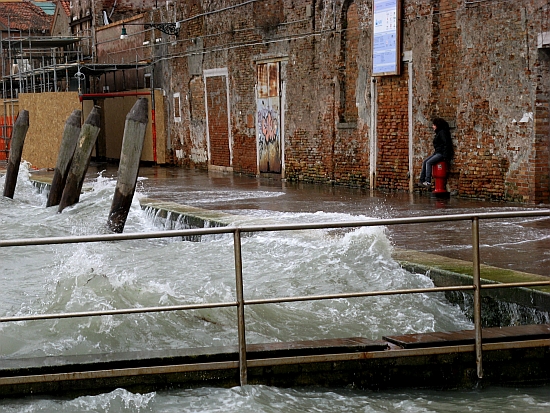We were all peacefully plodding along toward spring when March burst through the door. Did the famous month come in like a lion? More like a pack of enraged jaguars.
On Monday night (February 28) the wind began to pick up. A very special wind, the bora, blowing from the northeast with gusts up to 54 km/h (33 mph).

This went on all day and night for the following two days — as I write, the wind is finally subsiding to a polite 20 km/h (12 mph).
The scirocco, the fetid breath of the southeast, can impel acqua alta, but if you stand sideways to the bora it will blow your brain out of your skull. Not that you’ll be needing your brain at that point, because the survival instinct will have taken over the controls.
We could hear the powerful roaring noise with the door and windows shut. Women didn’t hang out their laundry, which told me more than even the messages being tapped out on our window by the desperate Venetian blinds. Normally you’d like a real breeze because it gives you a boost in the drying-laundry department, but here your housewife would have risked either seeing her underwear being ripped out of the clothespins and soaring away toward Sardinia, or clinging to the clothesline while being rent to rags, like a flag in a hurricane.
For me, not seeing laundry is more ominous than the dog that didn’t bark in the night.

But while all this is very exciting for Venice (well, for me, though it’s certainly not the first bora I’ve experienced), it set a record for Trieste, the city as famous for its wind as Venice is for its canals. They haven’t had a zephyr like this since 1954.
The Triestines endured this bora with gusts up to 163 km/h (101 mph). This is a speed which isn’t even on the Beaufort scale, and creates more damage and danger than 76 acqua altas put together. Some people in Trieste were literally blown over, suffering serious head injuries. The houses and trees went through something of the same thing. It’s quite a place where the weather person can breathe a sigh when he tells the viewers that the wind is dropping and that now it’s only at 70 km/h (43 mph).
Here is a view of the bora in Trieste at 150 km/h. This occurred in 2005, but it gives some idea of what 163 km/h might look like.
http://www.youtube.com/watch?v=itcaETv705Y&playnext=1&list=PL35DE065227480E8F
Interesting fact that sounds like folklore, except that I can confirm that it’s true: No matter how many days the bora may last, it always ends on an odd-numbered day. Like today. Strange, I know.
I stayed home and made my once-a-year batch of galani, to gorge on today (“Fat Thursday”). They didn’t come out as well as they did last year, and I am convinced that I changed nothing. Of course we’re eating them, but they fall short of sublime, which is disappointing. If I’m going to eat slivers of fat and sugar, they ought to be at least irresistible.

Call me deranged, but I’m blaming the bora. Cold high pressure from Russia meeting warm low pressure from the southwest right over our little hovel. I’m just glad that the roof tiles didn’t get blown away. Though I suppose I could have glued some galani on in their place.

6 Comments
Goodness! It looks like the bora will blow you all the way to Bora Bora! any connections to the name?
Some rapid research reveals that the original Tahitian name for the fabled island you mention was Pora Pora, mangled by early Europeans as Bolabolla or Bollabolla. Bora (the wind), variously known around the Mediterranean as bura, burja, and boras, derives from Boreas, the Greek god of the north wind. So it only looks like they’re relatives. And if the bora should ever blow in Bora Bora, it would finish tourism there forever.
Brrr. I experienced the dreaded bora last March, and understood the expression “stiff upper lip” very clearly. I hope this bora is the last one for this season.
Focus your hopes on something that might be doable, because we can get a bora anytime, regardless of month. it doesn’t really have a season (unlike the acqua alta, which gets all the attention). Keep those lips warm!
In Vienna winds above 100 km/h happen several times a year and we are indeed happy when it goes down to only 70 km/h! Obviously we do not have these bad-ass sea waves which look so impressive, but huge trees falling on cars and killing people….
But then, again, this all is nothing compared to tornados and hurricanes in many other parts of the world. Europe seems to be quite fortunate.
…except that in Europe sometimes there are tornados, too, of course… but not very often, it seems to me…